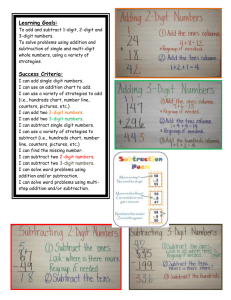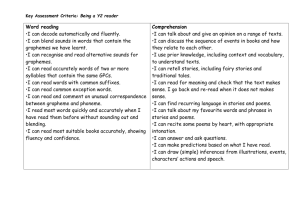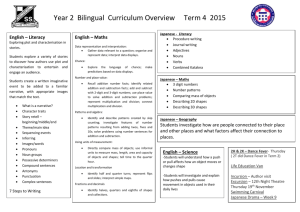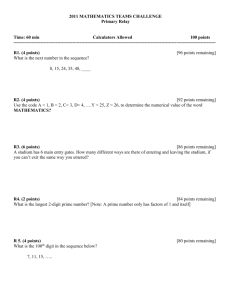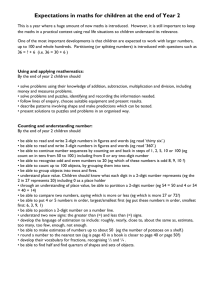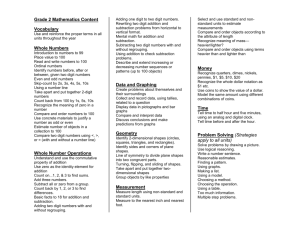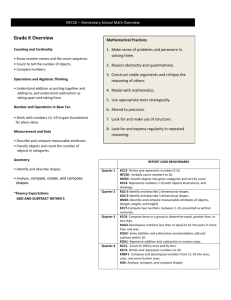Year 2 | Unit 7
advertisement
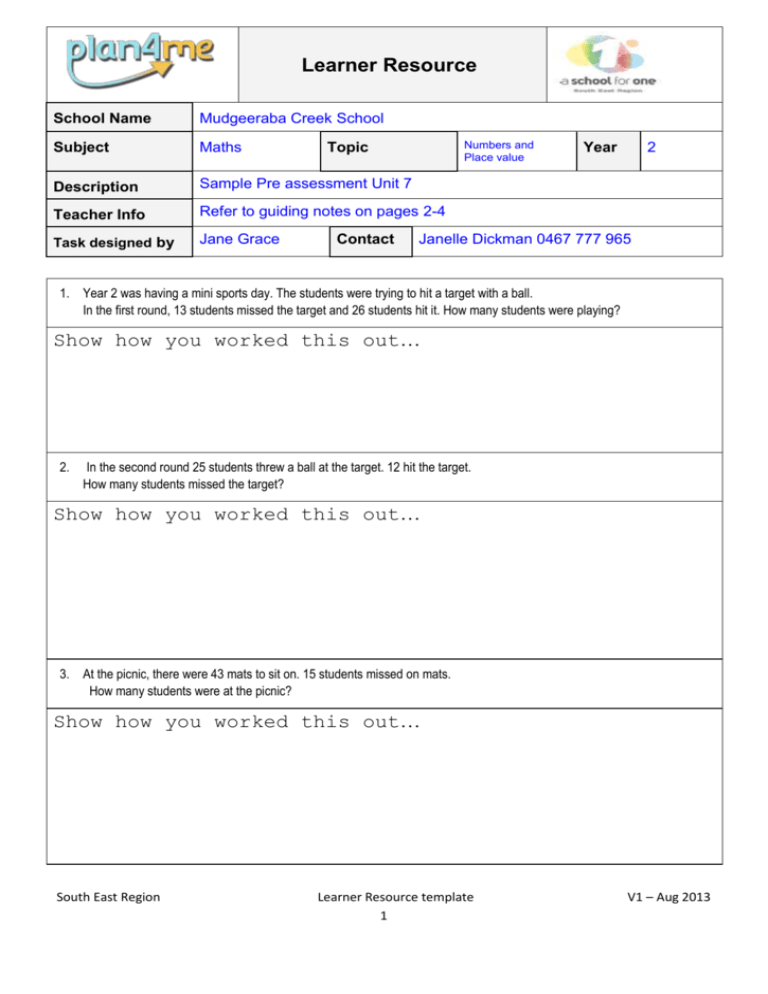
Learner Resource School Name Mudgeeraba Creek School Subject Maths Description Sample Pre assessment Unit 7 Teacher Info Refer to guiding notes on pages 2-4 Task designed by Jane Grace Numbers and Place value Topic Contact Year 2 Janelle Dickman 0467 777 965 1. Year 2 was having a mini sports day. The students were trying to hit a target with a ball. In the first round, 13 students missed the target and 26 students hit it. How many students were playing? Show how you worked this out… 2. In the second round 25 students threw a ball at the target. 12 hit the target. How many students missed the target? Show how you worked this out… 3. At the picnic, there were 43 mats to sit on. 15 students missed on mats. How many students were at the picnic? Show how you worked this out… South East Region Learner Resource template 1 V1 – Aug 2013 Learner Resource Teacher Guiding Notes DURATION CURRICULUM PLAN TOPICS 2 LESSONS Patterns and Algebra 13 LESSONS Number and Place Value *ASSESSMENT TASK 5 LESSONS Data representation / interpretation and chance *MONITORING TASK 5 LESSONS Using units of Measurement 25 LESSONS TOTAL UNIT *MONITORING TASK RATIONALE Due to the large focus on number in the previous 6 units (highlighted yellow in the table below), children have explored and worked with two and three digit numbers extensively. Teacher knowledge of student achievement in this area should be quite thorough however a simple pre-test to identify levels of mastery and some high order problem solving is appropriate to discover ability level of students in this area. THIS PRE-ASSESSMENT (see below) COULD BE USED ON THE REGIONAL TEMPLATE AND IS RELATED TO THE GTMJ OF THE SUMMATIVE TASK. One week devoted to data representation (highlighted purple) involving students to gather, record and interpret data in response to a question. As this has not been covered since unit 2, a webtool task in eTc Maths/ IXL Maths for Year 2 could provide the teacher with valuable insight into how children can interpret and predict data showing justification for their thinking. A screen shot could be taken and emailed to the teacher or this would be an excellent task to add to a virtual classroom. One week is devoted to measurement ( highlighted blue) and was last covered in Unit 3. It could be preassessed by asking the students to physically order and compare mass, length, area and capacity of objects and shapes based on a single attribute. Only two lessons are devoted to patterns and algebra. (highlighted green) It has not been covered since unit 3 and the teacher may need familiarise him/herself with the abilities of the children in this area. The focus is patterning and identifying missing elements so a simple sticky question could be sufficient. South East Region Learner Resource template 2 to note V1 – Aug 2013 TERM Sequencing teaching and learning Unit overviews 1 2 3 4 Unit 1: Unit 2: Unit 3: Unit 4: Unit 5: Unit 6: Unit 7: Unit 8: Students develop understandings of: Students develop understandings of: Students develop understandings of: Students develop understandings of:: Students develop understandings of: Students develop understandings of: Students develop understandings of: Students develop understandings of: Number and place Number and place Shape — recognise Number and place value — recall the value — represent and name familiar 2value — recall ones counting 2-digit numbers, D shapes, describe addition number sequence, partition 2-digit the features of 2D facts, identify investigate the 2s, numbers, round shapes, draw 2-D related 5s and 10s number numbers to the shapes, identify 3D subtraction sequences, nearest ten, add objects and number facts, represent two-digit strings of singledescribe the describe partnumbers, show digit numbers, add features of familiar part-whole standard and nonand subtract 23D objects relationships, standard place value digit numbers, solve addition Number and place partitioning, represent and subtraction value — represent represent addition multiplication and problems, add 2-digit numbers, and subtraction, use division, solve and subtract 2read and write 2part-part-whole simple digit numbers, digit numbers, reasoning to solve multiplication and represent partition 2-digit problems, add and division problems multiplication, numbers into place subtract 2-digit represent Data representation value parts, partition numbers (without division, solve and interpretation smaller numbers, bridging) simple grouping — collect simple consolidate familiar and sharing Using units of data e.g. sort and counting problems measurement — count, observe sequences, and order days of the events, ask explore the 3s Money and financial week and months of questions, record counting sequence mathematics — the year, use data in lists and describe the Patterns and algebra calendars to record tables, display features of — infer pattern rules and plan significant data in a picture Australian coins, from familiar events, connect graph, describe count coin number patterns, seasons to the outcomes of data collections, identify missing months of the year, investigations identify elements in compare lengths equivalent Chance — identify counting patterns, using direct combinations, every day events and solve simple comparison, identify $5 and that involve number pattern compare lengths $10 notes, count chance, describe problems using indirect small collections chance outcomes, Fractions and decimals comparison, of coins and describe events as —describe fractions Measure lengths notes likely, unlikely, as equal portions or using informal units certain, impossible Using units of shares, represent measurement — halves and quarters use a calendar, of shapes, represent identify the halves and quarters South East Region Number and place Number and place Patterns and algebra Shape — draw twovalue — count value — count to — describe dimensional beyond 100, and from 1000, number patterns, shapes, describe represent 3-digit represent 3-digit identify missing there-dimensional numbers, compare numbers, compare elements in objects and order 3-digit and order 3-digit number patterns Fractions and numbers, partition numbers, partition identify and decimals — 3-digit numbers, 3-digit numbers, describe patterns identify halves, read and write 3read and write 3created by skip quarter and eights digiti numbers, digit numbers, counting, of shapes and recall addition recall addition investigate collections number facts, number facts, features of number Using units of identify related identify related patterns resulting measurement — addition and addition and from adding twos, directly compare subtraction subtraction fives and 10s, mass of objects, number facts, add number facts, add solve problems use informal units and subtract with and subtract with using number to measure mass, 2-digit numbers 2-digit numbers, sentences for length, area and count large addition and Fractions — divide capacity of objects collections ansubtraction shapes and and shapes, collections into Money and financial Number and place compare and order halves, quarters mathematics — value — recall objects and and eighths, solve count collections addition number shapes based on a simple fraction of coins and notes, facts, identify single attribute problems make money related addition Location and amounts, read and and subtraction Using units of transformation — write money facts, add and measurement — identify half and amounts, compare subtract with 2compare and order quarter turns, money amounts digit and 3-digit objects, measure represent flips numbers, use length, area and Shape — identify and and slides place value to capacity using describe polygons, Number and place solve addition and informal units identify and value— recall subtraction describe 2D Location and addition number problems, shapes with transformation — facts, identify represent curved sides, draw describe the effect related addition multiplication and 2D shapes, of single-step and subtraction division, connect describe the transformations, facts, add and multiplication and features of 3including turns, subtract with 2division dimensional flips and slides, digit and 3-digit objects, identify 3Data representation identify turns, flips numbers, use dimensional and interpretation and slides in real place value to Learner Resource template V1 – Aug 2013 3 of collections, represent eighths of shapes and collections, describe the connection between halves, fourths and eighths, and solve simple number problems involving halves, fourths and eighths Location and transformation — interpret simple maps of familiar locations, describe ‘bird’s eye view’, use appropriate language to describe locations and give directions, use simple maps to identify locations of interest South East Region number of days in each month, relate months to seasons, tell time to the quarter hour, cover surfaces to represent area, compare area of shapes and surfaces, measure area with informal units world situations Learner Resource template objects in the environment Using units of measurement — identify purposes for calendars, explore seasons and calendars of indigenous people. — identify questions of interest based on one categorical variable, gather data relevant to a question, organise and represent data, interpret data displays solve addition and subtraction problems, represent multiplication and division, connect multiplication and division. Chance — explore the language of chance, make predictions based on data displays Using units of measurement — directly compare mass of objects, use informal units to measure mass, length, area and capacity of objects and shapes, compare and order objects and shapes based on a single attribute. V1 – Aug 2013 4
